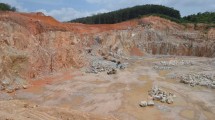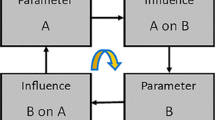Abstract
Flyrock is an adverse effect produced by blasting in open-pit mines and tunneling projects. So, it seems that the precise estimations and risk level assessment of flyrock are essential in minimizing environmental effects induced by blasting. The first aim of this research is to model the risk level associated with flyrock through rock engineering systems (RES) methodology. In this regard, 62 blasting were investigated in Ulu Tiram quarry, Malaysia, and the most effective parameters of flyrock were measured. Using the most influential parameters on flyrock, the overall risk of flyrock was obtained as 32.95 which is considered as low to medium degree of vulnerability. Moreover, the second aim of this research is to estimate flyrock based on RES and multiple linear regression (MLR). To evaluate performance prediction of the models, some statistical criteria such as coefficient of determination (R2) were computed. Comparing the values predicted by the models demonstrated that the RES has more suitable performance than MLR for predicting the flyrock and it could be introduced as a powerful technique in this field.











Similar content being viewed by others
References
Aguero A, Pinedo P, Simon I, Cancio D, Moraleda M, Trueba C, Perez-Sanchez D (2008) Application of the Spanish methodological approach for biosphere assessment to a generic high-level waste disposal site. Sci Total Environ 403:34–58
Amini H, Gholami R, Monjezi M, Torabi SR, Zadhesh J (2012) Evaluation of flyrock phenomenon due to blasting operation by support vector machine. Neural Comput Appl 21:2077–2085
Bahri Najafi A, Saeedi GR, Ebrahimi Farsangi MA (2014) Risk analysis and prediction of out-of-seam dilution in longwall mining. Int J Rock Mech Min Sci 70:115–122
Bajpayee TS, Rehak TR, Mowrey GL, Ingram DK (2004) Blasting injuries in surface mining with emphasis on flyrock and blast area security. J Saf Res 35:47–57
Benardos AG, Kaliampakos DC (2004) A methodology for assessing geotechnical hazards for TBM tunnelling—illustrated by the Athens Metro, Greece. Int J Rock Mech Min Sci 41:987–999
Faramarzi F, Ebrahimi Farsangi MA, Mansouri H (2013a) An RES based model for risk assessment and prediction of backbreak in bench blasting. Rock Mech Rock Eng 46:877–887
Faramarzi F, Mansouri H, Ebrahimi Farsangi MA (2013b) A rock engineering systems based model to predict rock fragmentation by blasting. Int J Rock Mech Min Sci 60:82–94
Faramarzi F, Mansouri H, Ebrahimi Farsangi MA (2014) Development of rock engineering systems-based models for flyrock risk analysis and prediction of flyrock distance in surface blasting. Rock Mech Rock Eng 47:1291–1306
Fouladgar N, Hasanipanah M, Bakhshandeh Amnieh H (2016) Application of cuckoo search algorithm to estimate peak particle velocity in mine blasting. Eng Comput. https://doi.org/10.1007/s00366-016-0463-0
Ghasemi E, Sari M, Ataei M (2012) Development of an empirical model for predicting the effects of controllable blasting parameters on flyrock distance in surface mines. Int J Rock Mech Min Sci 52:163–170
Ghasemi E, Amini H, Ataei M, Khalokakaei R (2014) Application of artificial intelligence techniques for predicting the flyrock distance caused by blasting operation. Arab J Geosci 7:193–202
Gupta RN (1980) Surface blasting and its impact on environment. In: Trivedy NJ, Singh BP (eds) Impact of mining on environment. Ashish Publishing House, New Delhi, pp 23–24
Hasanipanah M, Monjezi M, Shahnazar A, Jahed Armaghanid D, Farazmand A (2015) Feasibility of indirect determination of blast induced ground vibration based on support vector machine. Measurement. https://doi.org/10.1016/j.measurement.2015.07.019
Hasanipanah M, Naderi R, Kashir J, Noorani SA, Zeynali Aaq Qaleh A (2016a) Prediction of blast produced ground vibration using particle swarm optimization. Eng Comput. https://doi.org/10.1007/s00366-016-0462-1
Hasanipanah M, Jahed Armaghani D, Bakhshandeh Amnieh H et al (2016b) Application of PSO to develop a powerful equation for prediction of flyrock due to blasting. Neural Comput Appl. https://doi.org/10.1007/s00521-016-2434-1
Hasanipanah M, Jahed Armaghani D, MonjeziM Shams S (2016c) Risk assessment and prediction of rock fragmentation produced by blasting operation: a rock engineering system. Environ Earth Sci. https://doi.org/10.1007/s12665-016-5503-y
Hasanipanah M, Shahnazar A, Bakhshandeh Amnieh H, Jahed Armaghani D (2016d) Prediction of air-overpressure caused by mine blasting using a new hybrid PSO–SVR model. Eng Comput. https://doi.org/10.1007/s00366-016-0453-2
Hasanipanah M, Bakhshandeh Amnieh H, Arab H, Zamzam MS (2016e) Feasibility of PSO–ANFIS model to estimate rock fragmentation produced by mine blasting. Neural Comput Appl. https://doi.org/10.1007/s00521-016-2746-1
Hasanipanah M et al (2016f) Prediction of an environmental issue of mine blasting: an imperialistic competitive algorithm-based fuzzy system. Int J Environ Sci Technol. https://doi.org/10.1007/s13762-017-1395-y
Hasanipanah M, Shirani Faradonbeh R, Jahed Armaghani D, Bakhshandeh Amnieh H, Khandelwal M (2017) Development of a precise model for prediction of blast-induced flyrock using regression tree technique. Environ Earth Sci 76(1):27
Hudson JA (1992) Rock engineering systems: theory and practice. Ellis Horwood, Chichester
Hustrulid WA (1999) Blasting principles for open pit mining: vol 1, general design concepts. Balkema, Rotterdam
Institute of Makers of Explosives (IME) (1997) Glossary of commercial explosive industry terms. Safety Publication, No 12, Institute of Makers of Explosives, Washington, p 16
Jahed Armaghani D, Hajihassani M, Mohamad ET, Marto A, Noorani SA (2014) Blasting-induced flyrock and ground vibration prediction through an expert artificial neural network based on particle swarm optimization. Arab J Geosci 7:5383–5396
Jahed Armaghani D, Mohamad ET, Hajihassani M, Abad SANK, Marto A, Moghaddam MR (2015a) Evaluation and prediction of flyrock resulting from blasting operations using empirical and computational methods. Eng Comput. https://doi.org/10.1007/s00366-015-0402-5
Jahed Armaghani D, Hasanipanah M, Tonnizam Mohamad E (2015b) A combination of the ICA-ANN model to predict air-overpressure resulting from blasting. Eng Comput. https://doi.org/10.1007/s00366-015-0408-z
Jahed Armaghani D, Hasanipanah M, Bakhshandeh Amnieh H, Tonnizam Mohamad E (2016) Feasibility of ICA in approximating ground vibration resulting from mine blasting. Neural Comput Appl. https://doi.org/10.1007/s00521-016-2577-0
Jimeno CL, Jimeno EL, Carcedo FJA (1995) Drilling and blasting of rocks. Balkema, Rotterdam
Khandelwal M, Monjezi M (2013) Prediction of flyrock in open pit blasting operation using machine learning method. Int J Rock Mech Min Sci 23:313–316
Khandelwal M, Marto A, Fatemi SA, Ghoroqi M, Jahed Armaghani D, Singh TN, Tabrizi O (2017) Implementing an ANN model optimized by genetic algorithm for estimating cohesion of limestone samples. Eng Comput. https://doi.org/10.1007/s00366-017-0541-y
Konya CJ, Walter EJ (1991) Rock blasting and overbreak control. United States Department of Transportation, McClean
Langefors U, Kihlstrom B (1978) The modern technique of rock blasting. Wiley, New York
Little TN, Blair DP (2010) Mechanistic Monte Carlo models for analysis of flyrock risk. Rock fragmentation by blasting. Taylor and Francis, London, pp 641–647
Lu P, Latham J-P (1994) A continuous quantitative coding approach to the interaction matrix in rock engineering systems based on grey systems approaches. In: Proceedings of 7th international congress of the IAEG, Lisbon, Portugal, September. Balkema, Rotterdam, pp 4761–4770
Lundborg N, Persson N, Ladegaard-Pedersen A, Holmberg R (1975) Keeping the lid on flyrock in open pit blasting. Eng Min J 176:95–100
Marto A, Hajihassani M, Jahed Armaghani D, Tonnizam Mohamad E, Makhtar AM (2014) A novel approach for blast-induced flyrock prediction based on imperialist competitive algorithm and artificial neural network. Sci World J. https://doi.org/10.1155/2014/643715
Matthews M, Lloyd BJ (1998) The river test catchment surveillance project, South water utilities. Final research report. Department of Civil Engineering, University of Surrey, UK
Mohamad ET, Armaghani DJ, Mahdyar A, Komoo I, Kassim KA, Abdullah A, Majid MZA (2017) Utilizing regression models to find functions for determining ripping production based on laboratory tests. Measurement 111:216–225
Mokfi T, Almaeenejad M, Sedighi MM (2011) A data mining based algorithm to enhance maintenance management: a medical equipment case study. In: First international conference on informatics and computational intelligence (ICI). IEEE, pp 74–80
Mokfi T, Shahnazar A, Bakhshayeshi I, Mahmodi Derakhsh A, Tabrizi O (2018) Proposing a new soft computing-based model to predict peak particle velocity induced by blasting. Eng Comput. https://doi.org/10.1007/s00366-018-0578-6
Monjezi M, Bahrami A, Yazdian Varjani A (2010) Simultaneous prediction of fragmentation and flyrock in blasting operation using artificial neural networks. Int J Rock Mech Min Sci 47:476–480
Monjezi M, Khoshalan HA, Varjani AY (2012) Prediction of flyrock and backbreak in open pit blasting operation: a neurogenetic approach. Arab J Geosci 5:441–448
Monjezi M, Hasanipanah M, Khandelwal M (2013) Evaluation and prediction of blast-induced ground vibration at Shur River Dam, Iran, by artificial neural network. Neural Comput Appl 22:1637–1643
Rezaei M, Monjezi M, Yazdian Varjani A (2011) Development of a fuzzy model to predict flyrock in surface mining. Saf Sci 49:298–305
Sharma LK, Singh TN (2017) Regression based models for the prediction of unconfined compressive strength of artificially structured soil. Engineering with Computers. https://doi.org/10.1007/s00366-017-0528-8
Sharma LK, Singh R, Umrao RK, Sharma KM, Singh TN (2017a) Evaluating the modulus of elasticity of soil using soft computing system. Engineering with Computers 33(3):497–507
Sharma LK, Umrao RK, Singh R, Ahmad M, Singh TN (2017b) Geotechnical characterization of road cut hill slope forming unconsolidated geo-materials: a case study. Geotech Geol Eng 35(1):503–515
Sharma LK, Umrao RK, Singh R, Ahmad M, Singh TN (2017c) Stability investigation of hill cut soil slopes along national highway 222 at Malshej Ghat, Maharashtra, India. J Geol Soc India 89(2):165–174
Sharma LK, Vishal V, Singh TN (2017d) Predicting CO2 permeability of bituminous coal using statistical and adaptive neuro-fuzzy analysis. J Nat Gas Sci Eng 42:216–225
Sharma LK, Vishal V, Singh TN (2017e) Developing novel models using neural networks and fuzzy systems for the estimation of strength of rocks from key geomechanical properties. Measurement 102:158–169
Singh TN, Verma AK (2010) Sensitivity of total charge and maximum charge per delay on ground vibration. Geomat Nat Hazards Risk 1(3):259–272
Singh TN, Verma AK (2012) Comparative analysis of intelligent algorithms to correlate strength and petrographic properties of some schistose rocks. Eng Comput 28:1–12
Singh TN, Kanchan R, Verma AK (2004) Prediction of blast induced ground vibration and frequency using an artificial intelligent technique. Noise Vib Worldw 35(11):7–15
Singh TN, Singh R, Singh B, Sharma LK, Singh R, Ansari MK (2016) Investigations and stability analyses of Malin village landslide of Pune district, Maharashtra, India. Nat Hazards 81(3):2019–2030
Singh R, Umrao RK, Ahmad M, Ansari MK, Sharma LK, Singh TN (2017) Prediction of geomechanical parameters using soft computing and multiple regression approach. Measurement 99:108–119
Taheri K, Hasanipanah M, Bagheri Golzar S, Abd Majid MZ (2016) A hybrid artificial bee colony algorithm-artificial neural network for forecasting the blast-produced ground vibration. Eng Comput. https://doi.org/10.1007/s00366-016-0497-3
Trivedi R, Singh TN, Gupta N (2015a) Prediction of blast-induced flyrock in opencast mines using ANN and ANFIS. Geotech Geol Eng. https://doi.org/10.1007/s10706-015-9869-5
Trivedi R, Singh TN, Raina AK (2015b) Prediction of blast-induced flyrock in Indian limestone mines using neural networks. J Rock Mech Geotech Eng 6(5):447–454
Umrao RK, Singh R, Sharma LK, Singh TN (2017) Soil slope instability along a strategic road corridor in Meghalaya, northeastern India. Arab J Geosci. https://doi.org/10.1007/s12517-017-3043-8
Verma AK, Maheshwar S (2014) Comparative study of intelligent prediction models for pressure wave velocity. J Geosci Geomat 2(3):130–138
Verma AK, Singh TN (2009) A neuro-genetic approach for prediction of compressional wave velocity of rock and its sensitivity analysis. Int J Earth Sci Eng 2(2):81–94
Verma AK, Singh TN (2011) Intelligent systems for ground vibration measurement: a comparative study. Engineering with Computers 27(3):225–233
Verma AK, Singh TN (2013) Comparative study of cognitive systems for ground vibration measurements. Neural Comput Appl 22(1):341–350
Verma AK, Sirvaiya A (2016) Intelligent prediction of Langmuir isotherms of Gondwana coals in India. J Pet Explor Prod Technol 6(1):135–143
Yang Y, Zang O (1997) A hierarchical analysis for rock engineering using artificial neural networks. Rock Mech Rock Eng 30:207–222
Author information
Authors and Affiliations
Corresponding author
Ethics declarations
Conflict of interest
No potential conflict of interest was reported by the authors.
Rights and permissions
About this article
Cite this article
Hasanipanah, M., Jahed Armaghani, D., Bakhshandeh Amnieh, H. et al. A Risk-Based Technique to Analyze Flyrock Results Through Rock Engineering System. Geotech Geol Eng 36, 2247–2260 (2018). https://doi.org/10.1007/s10706-018-0459-1
Received:
Accepted:
Published:
Issue Date:
DOI: https://doi.org/10.1007/s10706-018-0459-1




